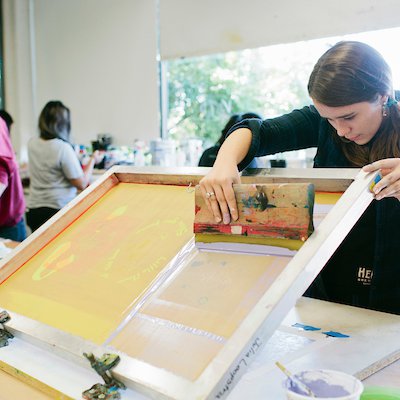The Necessary Guide to Understanding Screen Printing and Its Versatile Uses
Screen printing has an abundant history that goes back to ancient times, progressing into an advanced strategy made use of across various markets today. This guide checks out the intricacies of the screen printing procedure, outlining its applications in advertising and marketing, style, and home style - 10:9 Design LLC Company. Recognizing these basics can open imaginative potential for both imaginative and industrial projects. The complying with sections will certainly expose vital suggestions and strategies to enhance one's screen printing endeavors
The History of Screen Printing
Although screen printing has origins that map back centuries, its advancement mirrors the technical and imaginative innovations of numerous societies. Coming from ancient China, the strategy was initially utilized for embellishing textiles and later infect Japan, where it came to be indispensable to Ukiyo-e woodblock printing. The technique changed to Europe in the 18th century, where it acquired appeal among craftsmens and industrial printers. The innovation of picture emulsion in the 20th century reinvented screen printing, enabling for more complex styles and better effectiveness. Artists like Andy Warhol better thrust its popularity, utilizing the tool to create renowned works that combined commercialism and art. By the late 20th century, screen printing had developed itself as a versatile method, utilized in vogue, marketing, and great art. Today, it proceeds to progress, incorporating electronic technology and broadening its applications across various markets.
The Screen Printing Refine Explained
Screen printing changes creative visions into tangible designs through a series of precise actions. A photo is developed and after that transferred onto a screen, commonly made of fine mesh material extended over a frame. A light-sensitive emulsion is applied to the screen, which is subjected to light, hardening in areas not covered by the photo. After washing out the unhardened emulsion, a pattern is formed.
Next off, the screen is positioned over the substratum, whether it be material, paper, or another product. Ink is after that pushed through the open areas of the stencil using a squeegee, transferring the style onto the substratum below. This process can be repeated for multiple shades, requiring separate screens for each and every hue. The published item is healed using warmth to guarantee the ink sticks correctly, resulting in a resilient, vivid design prepared for usage.
Kinds of Screen Printing Techniques
In addition, specialty methods, such as discharge screen printing, get rid of dye from the textile to develop softer prints, while foil screen printing applies metallic foil to attain a shiny coating (10:9 Design Screen Printing Texas). Each strategy supplies unique features, satisfying various innovative demands and manufacturing ranges, inevitably broadening the possibilities within the screen printing domain name
Applications of Screen Printing in Numerous Industries

Additionally, the signage and advertising and marketing sectors use screen printing for developing distinctive displays and banners. This technique enables bold colors and elaborate layouts that record attention. my site In electronic devices, screen printing is utilized for using conductive inks to motherboard, essential for component connections. Furthermore, the home décor industry accepts screen printing to generate distinctive designs on textiles and wall art. On the whole, screen printing acts as a vital tool across varied fields, improving products with customized and visually attractive graphics.
Tips for Successful Screen Printing Projects
While carrying out a screen printing job, cautious attention to detail can considerably boost the last result. Initially, picking high-quality materials is essential; this consists of the screen, inks, and substratums. Utilizing suitable mesh counts can influence ink deposition and information resolution. Preparation is similarly crucial; thorough cleansing of displays and proper direct exposure times ensure crisp prints.
Next, precise registration is critical for multi-color prints. Making use of placement devices can assist achieve specific layering. Furthermore, screening prints on scrap materials prior to manufacturing helps recognize prospective issues without throwing away resources.

Frequently Asked Questions
What Materials Are Best for Screen Printing on Textile?
Cotton and polyester blends are ideal for screen printing on fabric as a result of their durability and ink absorption. In addition, specialized textiles like silk or canvas can generate special structures and finishes, enhancing the overall layout top quality.
Exactly how Do I Clean and Maintain Screen Printing Equipment?
To cleanse and keep screen printing equipment, one need to consistently clean screens with appropriate solvents, evaluate mops for wear, lubricate relocating components, and store all things in a completely dry, dust-free atmosphere to prolong their life-span.
What Are the Environmental Impacts of Screen Printing?
Screen printing can have substantial ecological impacts, consisting of chemical waste important link from solvents and inks, water usage throughout cleaning procedures, and energy consumption. Lasting practices and green materials are necessary for lessening these negative results.
Can Screen Printing Be Done in your home Effectively?
Screen printing can be properly done at home with the right products and strategies. Enthusiasts can produce top quality prints, though success depends on their skill degree, equipment, and understanding of the click for info procedure involved.
What Are the Expenses Associated With Starting a Display Printing Business?

Beginning a screen printing business involves prices for equipment, materials, and office. First expenditures generally range from a few hundred to a number of thousand bucks, relying on the range, top quality of machinery, and desired production capability.
Screen printing has a rich history that dates back to old times, progressing right into an innovative strategy made use of throughout various industries today. Another technique, rotary screen printing, employs cylindrical screens, facilitating continuous printing on fabric rolls, thereby enhancing efficiency for large-scale productions. Additionally, specialty techniques, such as discharge screen printing, remove color from the textile to develop softer prints, while foil screen printing applies metal foil to attain a shiny coating. In the style market, screen printing is widely used to create vibrant designs on apparel, making it possible for brand names to display their one-of-a-kind designs. Cotton and polyester blends are excellent for screen printing on fabric due to their longevity and ink absorption.